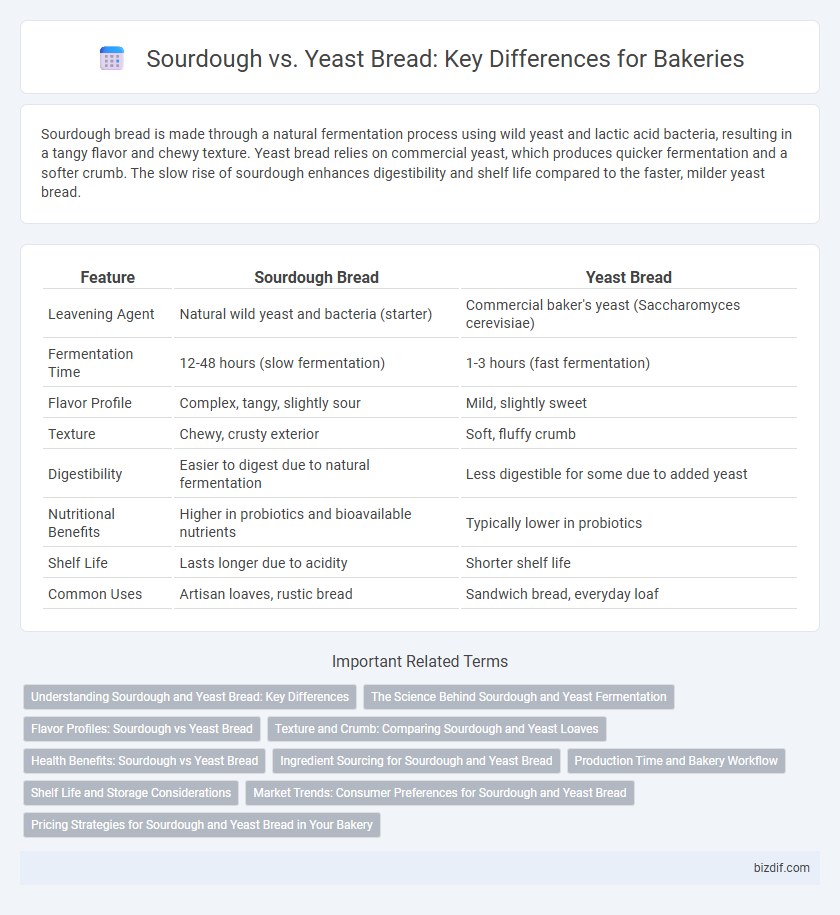Sourdough bread is made through a natural fermentation process using wild yeast and lactic acid bacteria, resulting in a tangy flavor and chewy texture. Yeast bread relies on commercial yeast, which produces quicker fermentation and a softer crumb. The slow rise of sourdough enhances digestibility and shelf life compared to the faster, milder yeast bread.
Table of Comparison
| Feature | Sourdough Bread | Yeast Bread |
|---|---|---|
| Leavening Agent | Natural wild yeast and bacteria (starter) | Commercial baker's yeast (Saccharomyces cerevisiae) |
| Fermentation Time | 12-48 hours (slow fermentation) | 1-3 hours (fast fermentation) |
| Flavor Profile | Complex, tangy, slightly sour | Mild, slightly sweet |
| Texture | Chewy, crusty exterior | Soft, fluffy crumb |
| Digestibility | Easier to digest due to natural fermentation | Less digestible for some due to added yeast |
| Nutritional Benefits | Higher in probiotics and bioavailable nutrients | Typically lower in probiotics |
| Shelf Life | Lasts longer due to acidity | Shorter shelf life |
| Common Uses | Artisan loaves, rustic bread | Sandwich bread, everyday loaf |
Understanding Sourdough and Yeast Bread: Key Differences
Sourdough bread is made through a natural fermentation process using wild yeast and lactobacilli bacteria, which contributes to its distinct tangy flavor and chewy texture. Yeast bread relies on commercial baker's yeast for a faster rise and a more neutral taste, resulting in a softer crumb and lighter texture. The fermentation time and microbial activity in sourdough enhance digestibility and shelf life compared to yeast bread.
The Science Behind Sourdough and Yeast Fermentation
Sourdough fermentation relies on wild yeast and lactic acid bacteria, producing carbon dioxide and organic acids that enhance flavor, texture, and shelf life. Yeast bread fermentation uses commercial baker's yeast, which rapidly converts sugars into carbon dioxide and ethanol, creating a lighter crumb and quicker rise time. The presence of lactic acid bacteria in sourdough not only contributes to its tangy taste but also improves the bread's nutritional profile and digestibility compared to yeast bread.
Flavor Profiles: Sourdough vs Yeast Bread
Sourdough bread offers a complex, tangy flavor profile developed through natural fermentation with wild yeast and lactic acid bacteria, imparting a slightly sour, earthy taste. Yeast bread, fermented with commercial baker's yeast, presents a milder, sweeter, and more consistent flavor, often with subtle hints of malt and wheat. The extended fermentation time of sourdough enhances its depth and aroma, distinguishing it from the quicker rising, softer texture of yeast bread.
Texture and Crumb: Comparing Sourdough and Yeast Loaves
Sourdough bread features a chewy texture with an open, irregular crumb due to wild yeast fermentation and longer proofing times, which enhance flavor complexity and moisture retention. In contrast, yeast bread typically has a softer, more uniform crumb and a tender, airy texture, resulting from commercial yeast that accelerates rising and creates consistent bubbles. The unique fermentation process in sourdough produces a denser, heartier loaf, while yeast bread prioritizes lightness and softness.
Health Benefits: Sourdough vs Yeast Bread
Sourdough bread offers superior health benefits compared to yeast bread due to its natural fermentation process, which enhances nutrient absorption and promotes gut health through beneficial probiotics. The lactic acid bacteria in sourdough lower the bread's glycemic index, making it a better option for blood sugar management. Yeast bread often contains additives and lacks the probiotic qualities that support digestion and reduce inflammation associated with sourdough.
Ingredient Sourcing for Sourdough and Yeast Bread
Sourdough bread relies on wild yeast and lactic acid bacteria naturally present in flour and the environment, requiring carefully sourced organic grains and local flour to optimize microbial activity. Yeast bread depends on commercially cultivated baker's yeast, which demands consistent, industrially produced ingredients like refined flour and controlled additives for predictable fermentation. Sourdough's ingredient sourcing emphasizes natural microbiota and artisanal flour quality, whereas yeast bread prioritizes standardized, mass-produced components for uniform results.
Production Time and Bakery Workflow
Sourdough bread requires extended fermentation, often 12 to 24 hours, which necessitates careful scheduling in bakery workflow to accommodate long proofing stages. Yeast bread, by contrast, typically completes production within 3 to 5 hours, allowing faster turnover and higher daily output. Balancing these timelines is essential for optimizing bakery operations and meeting product demand efficiently.
Shelf Life and Storage Considerations
Sourdough bread typically has a longer shelf life than yeast bread due to its natural fermentation process, which produces organic acids that inhibit mold growth. Proper storage for sourdough includes keeping it in a paper bag at room temperature, which maintains crust crispness while preventing excess moisture. Yeast bread often requires airtight containers or plastic bags to retain softness but may stale faster and develop mold more quickly than sourdough.
Market Trends: Consumer Preferences for Sourdough and Yeast Bread
Consumer preferences in the bakery market show a growing demand for sourdough bread due to its perceived health benefits and artisanal quality, driving significant sales growth in specialty bakeries. Yeast bread maintains a strong presence thanks to its affordability and consistent texture, appealing to budget-conscious and convenience-seeking customers. Market trends indicate that the fusion of traditional sourdough processes with modern yeast techniques is gaining traction, meeting diverse consumer tastes and expanding product variety.
Pricing Strategies for Sourdough and Yeast Bread in Your Bakery
Pricing strategies for sourdough bread often reflect its higher production costs, including longer fermentation times and the use of natural starters, justifying a premium price point in your bakery. Yeast bread, with shorter rising times and more predictable production processes, can be priced more competitively to attract everyday customers. Balancing these approaches allows your bakery to cater to diverse market segments while maximizing profit margins on artisan sourdough and volume sales on yeast-based products.
Sourdough vs Yeast Bread Infographic

 bizdif.com
bizdif.com